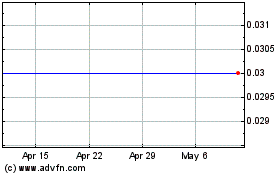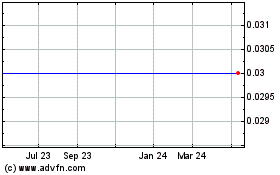Pancontinental Uranium Corporation (TSX VENTURE:PUC) ("Pancon") and
its Joint Venture partner, Crossland Uranium Mines Limited
(ASX:CUX) ("Crossland"), the operator, are pleased to update
shareholders on progress on the Charley Creek REE project.
HIGHLIGHTS
-- In the alluvial plains east of the Cockroach Prospect, recent assays of
aircore samples show strong indications for very large volumes of
alluvium containing Heavy Minerals (HM) with high concentrations of Rare
Earth Elements (REE). Testing and advancing the potential of these
extensive alluvial plains is now the most important priority for REE
exploration at Charley Creek.
-- In the alluvial plains, the average depth of alluvium encountered in 220
scout aircore holes over an area of approximately 150 sq. km. is 17
metres, indicating a volume of alluvium in this area of several billion
cubic metres.
-- The recent assays of these aircore samples indicate that levels of Total
Rare Earth Oxides (TREO) are relatively high (698 four metre composite
samples average 304g/t TREO, with values up to 1,000g/t) and are uniform
over large areas and are up to over 20 metres thick, commencing from
surface. Testwork already completed indicates that the REE are largely
present in HM that are readily concentrated to very high grades of TREO
using familiar sand mining technology.
To view Figure 1, please click on the following link:
http://media3.marketwire.com/docs/panconfigure11116.jpg
-- At the Cockroach Prospect, a pilot Resource estimate, based on
Australia's Joint Ore Reserves Committee ("JORC") standards which are
non-compliant with NI 43-101, of alluvial deposits containing REE is
essentially complete. However, recent check assay results of REE
concentrates from a second laboratory are indicating substantially
different (higher) REE contents than those obtained from Crossland's
regular laboratory for equivalent samples. Crossland is working to
resolve this issue as quickly as possible so that the JORC (non NI 43-
101 compliant) resource estimate of the Cockroach resource can be
released.
-- Due to prevailing poor financial market conditions, in conjunction with
the delayed JORC resource estimate, Pancon has elected to conserve its
cash and avoid having to raise additional funds at depressed share
prices. As a result, Pancon will cease funding its 50% share of the
Joint Venture expenditures until the end of 2011. Pancon expects its
interest will be reduced by 2 - 4%. According to the Joint Venture
agreement, Pancon has the right to resume funding at any time to
maintain its interest.
To view Figure 2, please click on the following link:
http://media3.marketwire.com/docs/panconfigure21116.jpg
POTENTIAL FOR LARGE SCALE ALLUVIAL REE DEPOSITS
Recent assay results of aircore drill samples highlight the
potential for very large volumes of alluvium containing significant
Rare Earth Elements (REE) in the Charley Creek tenements.
The Landsat satellite image in Figure 3 shows outwash fans
extending north from the outcropping REE bearing Proterozoic
granites and metamorphic rocks onto extensive plains of Quaternary
alluvium that hosts the REE bearing heavy minerals. These
Proterozoic rocks are the source of the REE in the alluvium. The
recent assays of 4m composite samples indicate that levels of Total
Rare Earth Oxides (TREO) are relatively high (200-1,000g/t) and
uniform over large areas, up to 10 kms from apparent source
outcrop, and up to over 20 metres thick, commencing from
surface.
To view Figure 3, please click on the following link:
http://media3.marketwire.com/docs/panconfigure31116.jpg
The widespread nature of the anomalous alluvial REE
mineralization in scout aircore holes provides encouragement for
the existence of very large quantities of alluvium with an REE
content that may support a high throughput/low unit cost alluvial
mining project that recovers the REE minerals, monazite and
xenotime. Figure 2 shows the extent of Quaternary alluvium that
warrants further investigation. Figures 4 and 5 cover the inset
area which is the main area of current investigation. Figure 4
shows the locations of scout aircore holes for which samples have
been received and colour coded to indicate average TREO levels for
the entire intervals of alluvium intersected. Figure 5 shows the
locations of scout aircore holes and indicates the thickness of
alluvium intersected.
By hard-rock REE deposit standards the assay values are not
high, however the alluvial material is easily treatable using
familiar and low-cost methods to produce high grade HM concentrates
of monazite and xenotime that have previously been shown by
Crossland to be extractible using physical processing. The
potential scale of the deposits is very large. The average depth of
alluvium encountered in 220 scout aircore holes over an area of
approximately 150 sq. km. is 17 metres, indicating a volume of
alluvium in this area of several billion cubic metres.
To view Figure 4, please click on the following link:
http://media3.marketwire.com/docs/panconfigure41116.jpg
To view Figure 5, please click on the following link:
http://media3.marketwire.com/docs/panconfigure51116.jpg
So far, exploration work on these larger alluvial plains has
been of a scoping nature only, consisting of widespread stream
sediment sampling (previously reported on) and several lines of
scout aircore drillholes in 2011, for a total of 220 holes. An
economic assessment of the area will require a great deal more
detailed drilling, sampling, assaying and metallurgical test
work.
Samples from the alluvium intersected in aircore holes in three
alluvial fan areas are being processed to produce gravity
concentrates of heavy minerals which are assayed to determine
recoverable heavy mineral grades. A total of 596 samples from the
Cattle Creek Area have been submitted to the laboratory; 191
samples from Western Dam have been processed and are ready to
submit, while a further 360 samples from Dad's Dam are currently
being processed for submission to assay laboratories. Metallurgical
test work is also in progress to determine the recoverability of
pure mineral concentrates and a process route for production of
valuable HM products. Results of this work will be released as they
are received and interpreted.
COCKROACH PROSPECT RESOURCE ESTIMATE
The pilot resource study on alluvials at the Cockroach Prospect
is essentially complete. These alluvials are relatively shallow
(average depth 1.2m), and about 17 million bank cubic metres of
alluvium will fall within Resource outlines in two separate
drainage basins. The drainages were close to an obvious source of
REE minerals in the Teapot Granite, so in the early stages of the
REE study, they represented a low risk opportunity to develop the
methodology for defining and estimating an alluvial REE resource
and to produce concentrates of monazite, xenotime and other heavy
minerals. The study has provided valuable materials for testing,
and knowledge that future REE alluvial resource evaluations will
draw on. It will also provide a supplemental resource to the larger
deposits in the alluvial fans discussed above.
Determination of the recoverable grade of the resource relies on
back-calculating the assays of HM concentrates produced by
Crossland's gravity and magnetic separation sample processing
procedure. These concentrate grades are high, frequently in the
range 5 - 50% TREO, depending on the HM mix. As a final stage in
the preparation of a JORC-compliant (non NI 43-101 compliant)
Resource, a due diligence program of check drilling, sampling and
assaying was undertaken on 88 repeat samples from 56 twinned holes,
with assaying conducted at two reputable laboratories. The results
of this study appear to indicate significantly different (higher)
recovered TREO grades when compared with the regular method used to
estimate the resource, and it appears that analysis of such high
value REE concentrates may be challenging current routine
analytical technology. This issue must be explained before
Crossland is able to release a JORC-compliant (non NI 43-101
compliant) estimate of recoverable HM resource. Crossland and
Pancon apologize for this delay, and Crossland is working with the
laboratories to ensure the assay results are reliable before a
JORC-Compliant (non NI 43-101 compliant) resource will be
released.
All technical information in this release has been reviewed by
Geoff Eupene, Qualified Person for Crossland and Pancon.
About Pancontinental Uranium Corporation
Pancontinental Uranium Corporation ("Pancon") is a
Canadian-based company focused on uranium and REE discovery and
development. Through a joint venture with Crossland Uranium Mines
Limited ("Crossland") of Australia, Pancon has established one of
the strongest management teams in the uranium industry. This
management and operating team has unparalleled experience from
exploration, through development to operations, and includes people
who were instrumental in the discovery of two of the largest
uranium deposits in the world. Pancon and Crossland hold an
impressive uranium and REE exploration portfolio with projects in
prolific, mining friendly districts.
Active exploration is ongoing at three Australian projects which
include Chilling, Charley Creek, and Kalabity. The Chilling project
has the potential to host a mirror image of a portion of the
renowned Alligator Rivers Uranium Field containing the large
Jabiluka, Ranger and Koongarra deposits. Charley Creek has the
potential for large alluvial REE deposits, and large, lower-grade,
Rossing-type, granite-hosted uranium deposits. The Kalabity project
lies in a district of historic uranium/radium mining that contains
a variety of known uranium deposit styles.
Pancon earned an initial 50% interest in this significant
uranium and REE project portfolio with Crossland through the
expenditure of AUD$8 million. Pancon and Crossland are also
pursuing exploration beyond Australia through an international
subsidiary company, Crosscontinental Uranium Limited, and plans
include formulating an exploration program in Burkina Faso.
ON BEHALF OF THE BOARD OF DIRECTORS
Rick Mark, President & CEO
Cautionary Language and Forward Looking Statements
This press release may contain "forward-looking statements",
which are subject to various risks and uncertainties that could
cause actual results and future events to differ materially from
those expressed or implied by such statements. Investors are
cautioned that such statements are not guarantees of future
performance and results. Risks and uncertainties about the
Company's business are more fully discussed in the Company's
disclosure documents filed from time to time with the Canadian
securities authorities.
Neither TSX Venture Exchange nor its Regulation Services
Provider (as that term is defined in the policies of the TSX
Venture Exchange) accepts responsibility for the adequacy or
accuracy of this release.
Contacts: Pancontinental Uranium Corporation Richard Mark
President and CEO 604-986-2020 or 1-866-816-0118 Pancontinental
Uranium Corporation Keith Patey Director of Communications
604-986-2020 or 1-866-816-0118www.PanconU.com
Pancontinental Resources (TSXV:PUC)
Historical Stock Chart
From Dec 2024 to Jan 2025

Pancontinental Resources (TSXV:PUC)
Historical Stock Chart
From Jan 2024 to Jan 2025
